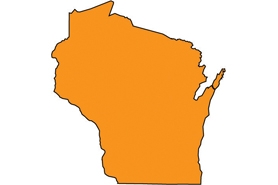Multiflora rose
(Rosa multiflora)
Thorny, thicket-forming shrub with broad, arching, climbing canes and stiff, curved thorns. It can reach 10-15’ tall and 9-13’ wide. Typically more spreading than erect.
Other names for this plant include:
- Common names: Japanese rose, many-flowered rose
- Scientific names: R. cathayensis; R. multiflora var. carnea
Classification in Wisconsin: Restricted
- Ecological Threat
-
- Multiflora rose invades open woodlands, forest edges, old fields, roadsides, savannas and prairies. It can tolerate various soil and environmental conditions and full or partial sun. It does best on well-drained soils.
- It is highly prolific and can form impenetrable thickets that exclude native plant species.
- Introduced from Japan in 1886 as rootstock for cultivated roses, it has been planted widely to curb soil erosion, as a living fence and as a source of food and cover for wildlife.
- Produces up to 500,000 seeds per year. Seeds remain viable in the soil for 10 to 20 years.
- Identification
-
Leaves: Alternate, pinnately compound with 5-11 small (0.5-1”) sharply-toothed oval leaflets, nearly smooth on the upper surface and paler with short hairs on the underside—pair of fringed stipules (a leaf-like structure) at the base of each leaf.
Flowers: Abundant, showy, fragrant, and white to slightly pink, Flowers are ½ -1 ½” wide and form a panicle (a pyramidal, loosely branched flower cluster)—blooms mid-to-late spring.
Fruits & seeds: Clusters of small (0.25” in diameter), hard, bright red fruits or rose hips develop in summer, become brownish-red at maturity and remain on the plant through winter. Birds and mammals disperse them.
Roots: Stolons (horizontal stems) can root at the nodes; arching branches can root at their tips.
Similar species: Native roses are distinguished by stipules with entire margins and slender, straight thorns. Most native roses also have pink flowers.
- Control
-
Mechanical: Pull or dig up small plants. Larger plants can be pulled with a chain, tractor or bulldozer. Be sure all roots are removed since new plants can develop from root fragments. Mow 3 to 6 times during the growing season for 2 to 4 years. Early spring burns can be effective in fire-adapted communities, but areas must be monitored for seedlings and resprout.
Chemical: Cut stump treatment with glyphosate—basal bark treatment with triclopyr ester. Treat budding or flowering plants foliage with glyphosate or metsulfuron-methyl plus a surfactant. Treat vegetation with fosamine and water solution in late summer to prevent bud development the following year.
Biological: Several biocontrol agents show potential: a native viral pathogen (rose rosette disease), which is spread by an eriophyid mite (P. fructiphilus); a seed-infesting wasp (M. aculeatus var. nigroflavus); and a stem girdler (Agrilus aurichalceus) (Amrine 2003).
For more information on control techniques, visit the Multiflora rose factsheet [exit DNR] by the University of Wisconsin-Extension.
- Resources
- Sources for content:
- Czarapata, Elizabeth; Invasive Plants of the Upper Midwest: an illustrated guide to their identification and control. The University of Wisconsin Press. 2005. Pg. 43-44
- Amrine, J.W. Jr. Multiflora rose [exit DNR] in Van Driesche, R. et al., 2002, Biological Control of Invasive Plants in the Eastern United States, USDA Forest Service Publication FHTET-2002-04, 413 p. Last updated Nov. 5, 2003.
- Plant Conservation Alliance’s Alien Plant Working Group: Fact Sheet. Multiflora rose [exit DNR]. Last updated Feb. 12, 2009.


